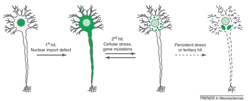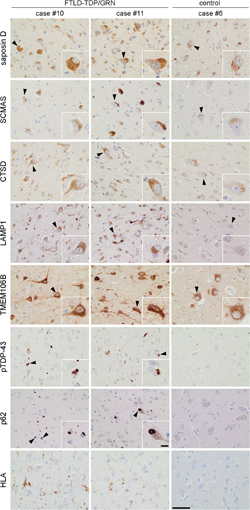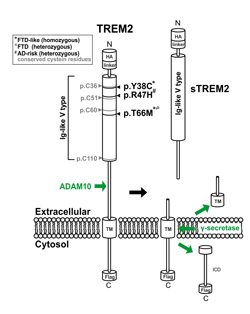Content
Frontotemporal Lobar Degeneration (FTLD)
FTLD and ALS research
RNA binding proteins, risk factors and lysosomal dysfunction
Frontotemporal Lobar Degeneration (FTLD) is a fatal neurodegenerative disorder for which no cure is available. Although it is a rare disorder FTLD is the second most common form of dementia below the age of 65 after Alzheimer’s disease. FTLD is a disease syndrome, which overlaps with Amyotrophic Lateral Sclerosis (ALS). In our lab we are specifically interested in RNA binding proteins, which are cleared from the nucleus and deposited in the cytsosol. These proteins include FUS, TDP-43 and hnRNPA1, A2 and A3. We are also investigating other risk factors such Progranulin and TMEM106B, which apparently affect lysosomal function. Two hit Figure aus dem Dormann Review und lysosmal IHC
Figure 1: General model showing how multiple
hits may lead to the formation of TDP-43 or
FUS pathology.
Figure 2: Increase of the major NCL storage
components and of lysosomal proteins in
brains of FTLD-TDP/GRN patients
Disease overlapping mechanisms - neuroinflammation and microglia
Another focus is disease-overlapping mechanisms. Here TREM2 plays a key role as mutations in TREM2 have been linked to a variety of different neurodegenerative disorders including FTLD, Alzheimer's disease, Parkinson’s disease and ALS. TREM2 is expressed in microglia and involved in phagocytic clearance of amyloid plaques and cellular debris, an essential function, which is reduced by the disease associated mutations. We believe that TREM2 may be target to modulate progression of whole set of neurological disorders. We collaborate with DIAN to determine TREM2 expression and function during disease progression.
Figure 3: TREM2 processing
Funding
MetLife Award for Medical Research
Cure Alzheimer’s Fund
Munich Cluster for Systems Neurology, DFG (EXC 1010 SyNergy)
Kompetenznetz Degenerative Demenzen – FTD
Further reading
TDP-43 and FUS: a nuclear affair
TREM2 mutations implicated in neurodegeneration impair cell surface transport and phagocytosis
Responsible for content: Prof. Dr. Dr. h.c. Christian Haass




